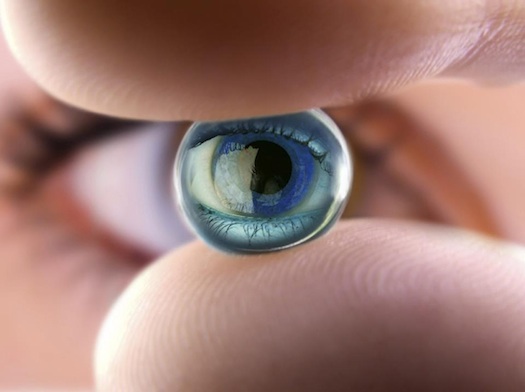

Previously blind patients who receive the recently FDA-approved Argus II bionic eye system will regain some degree of functional sight. The retinal implant technology, developed and distributed by Second Sight, can improve quality of life for patients who have lost functional vision due to retinitis pigmentosa, a disease that causes retinal cells to die. But the implant doesn’t facilitate a sudden recovery of 20/20 vision.
Just as cochlear implants don’t have the sensitivity to accurately relay the complex mix of frequencies in music, bionic vision through the Argus II will be closer to a very grainy black-and-white film than an HD movie.
The multi-piece system starts with a digital camera mounted in eyeglasses. Images from the camera get translated into data through a miniature computer and sent via wireless transmitter to a computer chip on the side of the eyeball. From there, the chip activates an eyelash-thin electrode array implanted behind the retina, which then stimulates retinal cells to send visual information to the brain.
Bionic vision will be closer to a very grainy black-and-white film than an HD movie.While the prosthesis sounds complex, it doesn’t compare to the intricacy of the natural human eye. Shawn Kelly, a scientist at Carnegie Mellon University, is currently working on his own retina implant system that includes the same basic technology as the Argus II. He explains that, with the technology available now, the electrode array isn’t finely tuned enough to produce the same detail and clarity of a fully functional human retina.
“It’s not going to be anything like normal vision,” Kelly says, describing the expected results of his implant. “It’s going to be very difficult to convey colors, and it’s going to be difficult to convey the type of visual resolution that we have in the center of our vision.”
The eye’s retinal cells, commonly known as rods and cones, are split up into six types of receptors that detect contrast between light and dark, red and green, and blue and yellow. Electrical signals from the retinal cells travel through the optic nerve to the brain to form a complete picture of what the eye is looking at.
Instead of trying to imitate the activity of all six receptor types, Second Sight’s Argus II implant focuses on stimulating retinal cells to show light and dark contrast. For a blind patient using an artificial retina, being able to detect the relative darkness of a hole or an approaching wall is a lot more important to independently navigating than knowing whether that wall is painted red or blue.
Brian Mech, vice president of business development at Second Sight, reports that in clinical trials, all of the company’s 30 patients had some degree of vision improvement after receiving the retinal implant. “Basically they see black and white, shades of gray and they’re getting somewhere between 50 and 60 pixels of information on average,” Mech says.
In terms of acuity, the patient with the best result went from no useful sight to 20/1260 vision. This ratio means that to get the same amount of information a healthy human eye can discern from 1,260 feet, this patient would need to be standing 20 feet away.
Mech admits this level of acuity is limited. “[It] is still pretty poor considering normal vision is 20/20, but it’s pretty amazing when you’re completely blind to begin with,” he says. But he explains that as research and testing continues, there is plenty of room to improve the system’s performance just by working on the external technology. Even color vision is a possibility with improvements to the video processor and wireless transmitter. “I don’t want to make it sound too easy,” Mech says. “There’s a lot of work to be done before we can do color vision, but the good news is that they won’t need a new implant for it.”
Second Sight is currently developing more advanced retinal implants, but the timeline is still unclear. Mech says it will be five to seven years or more before the next generation of implants becomes a reality.
This story was produced in partnership with Northwestern University’s Medill School of Journalism. For more FYIs, go here.
